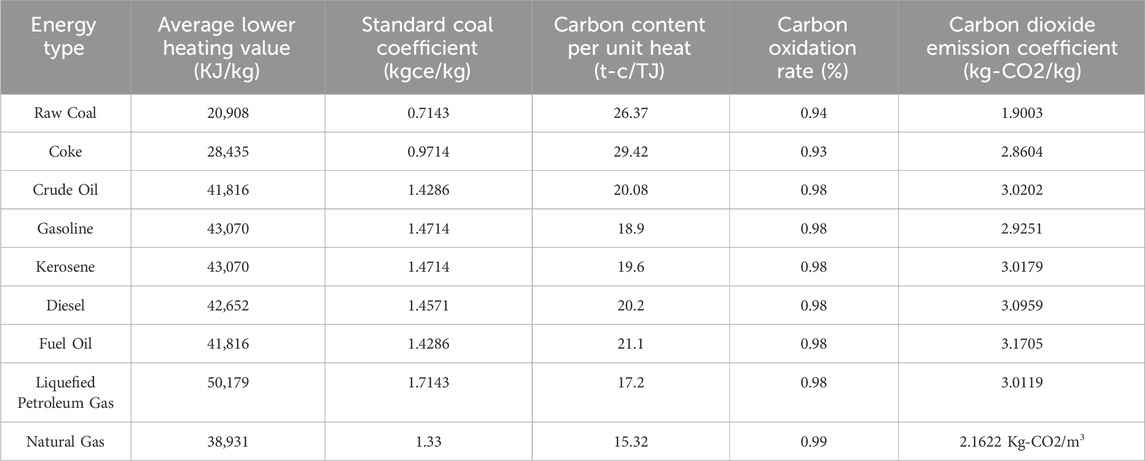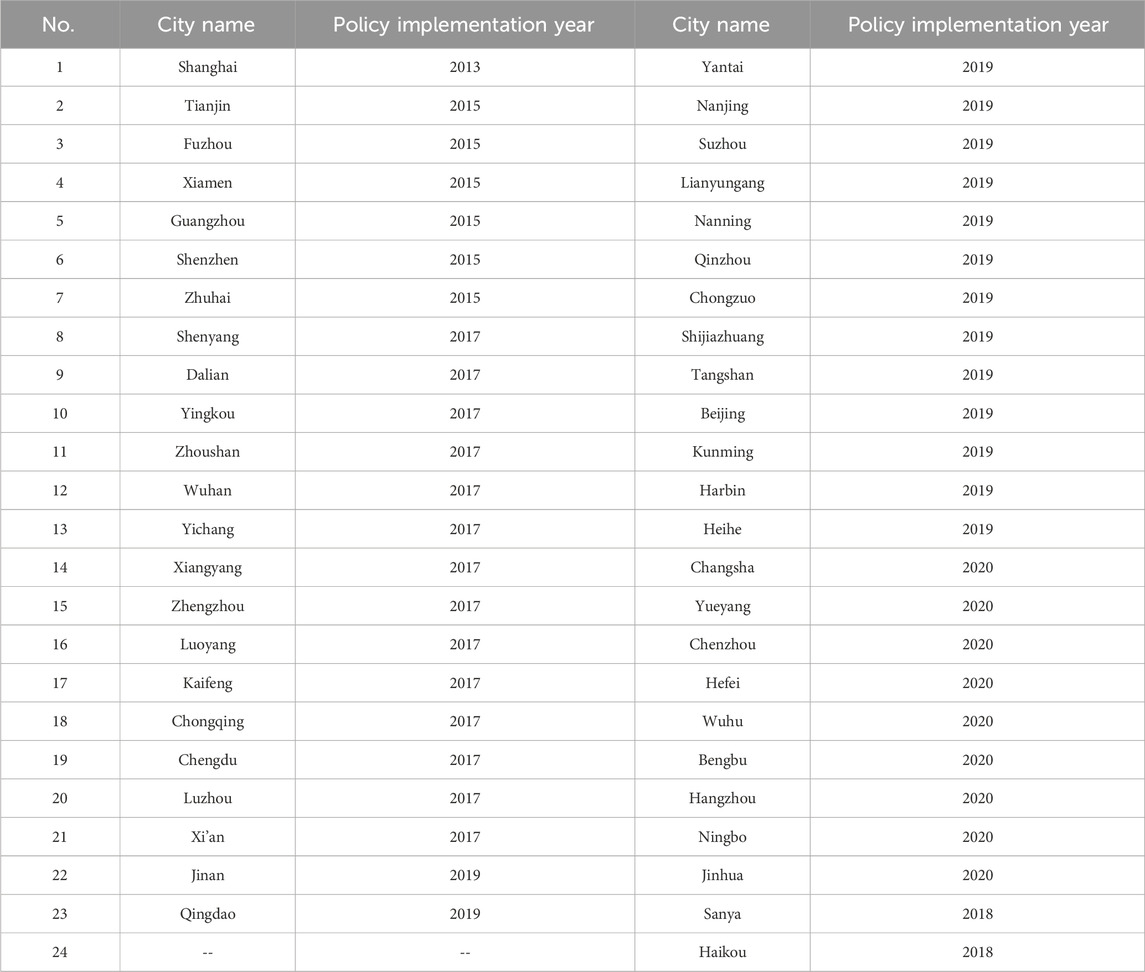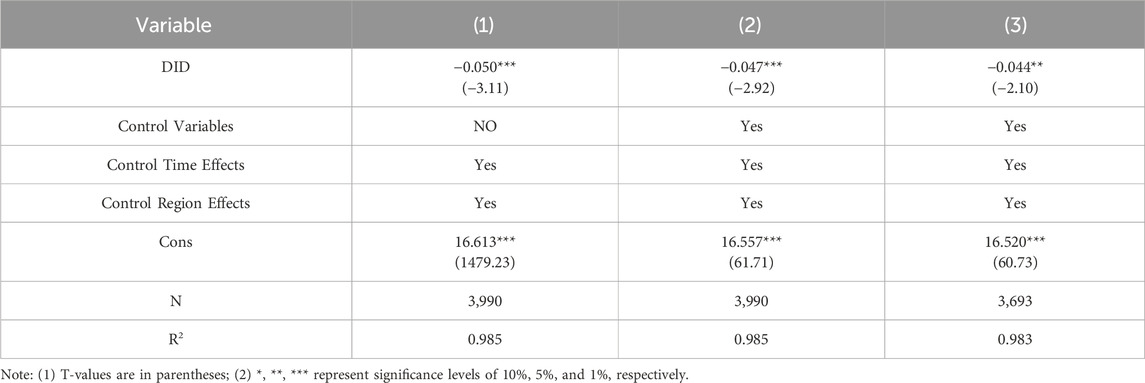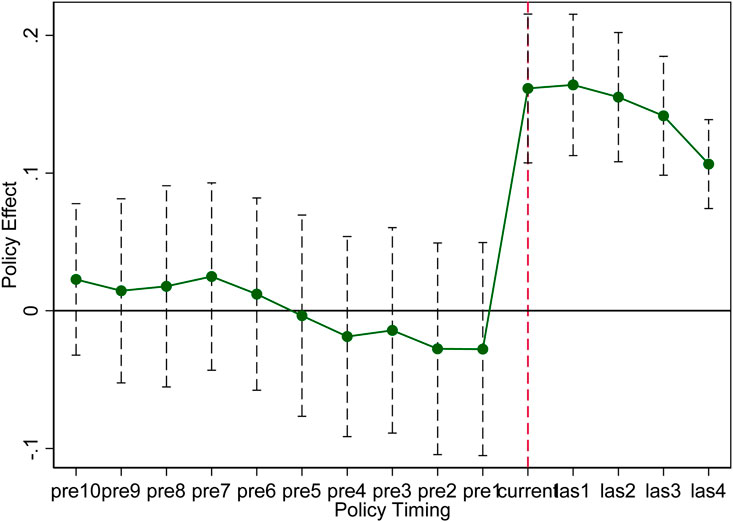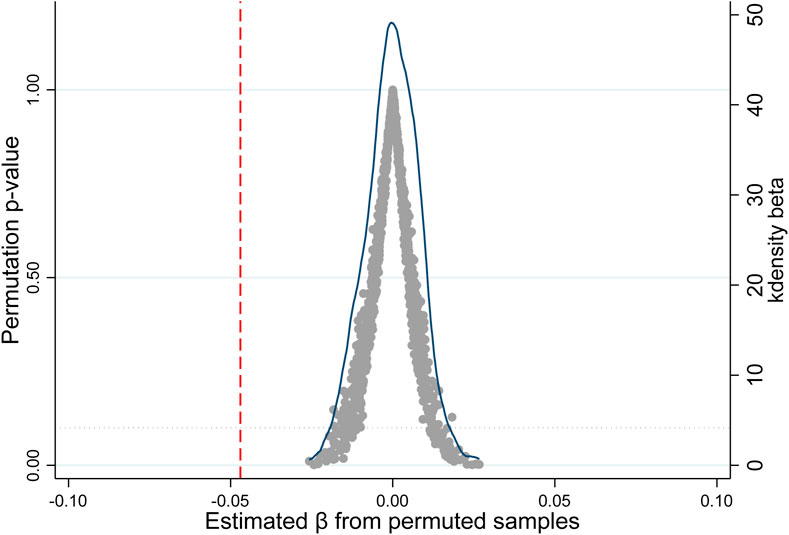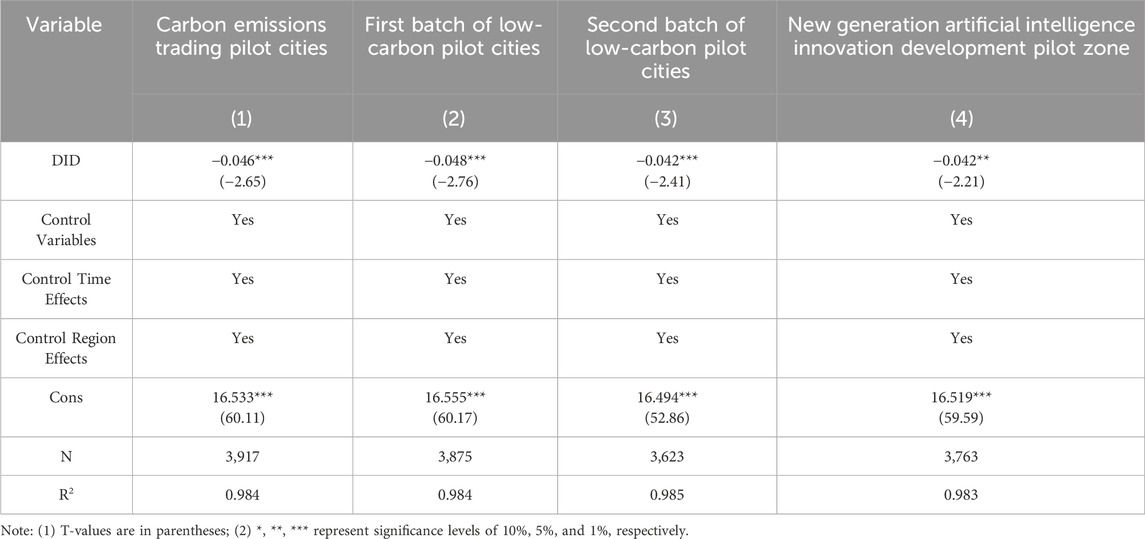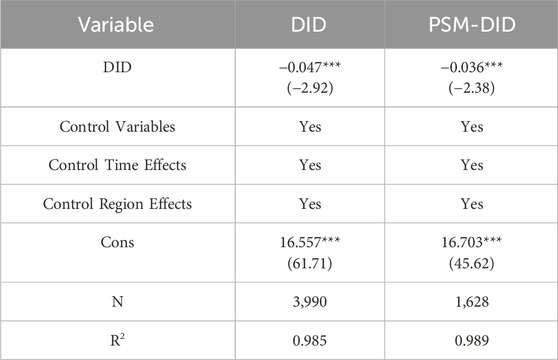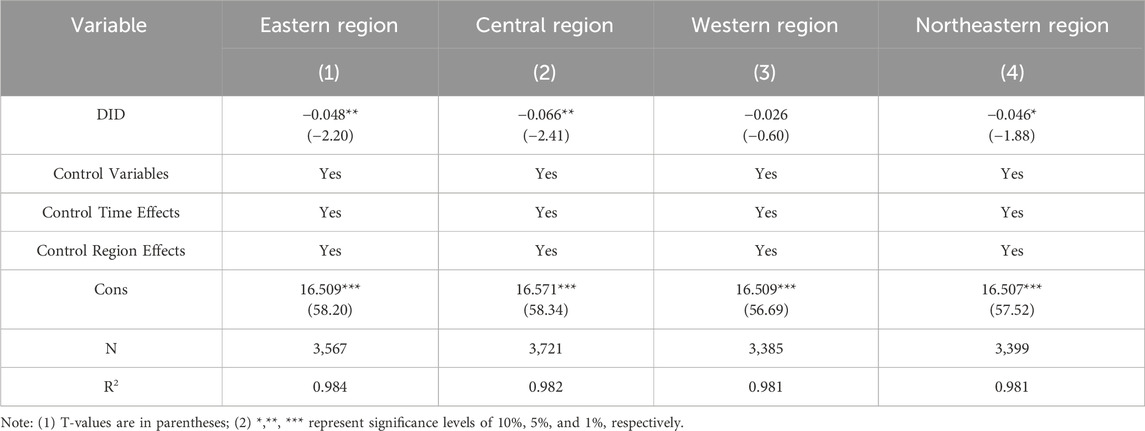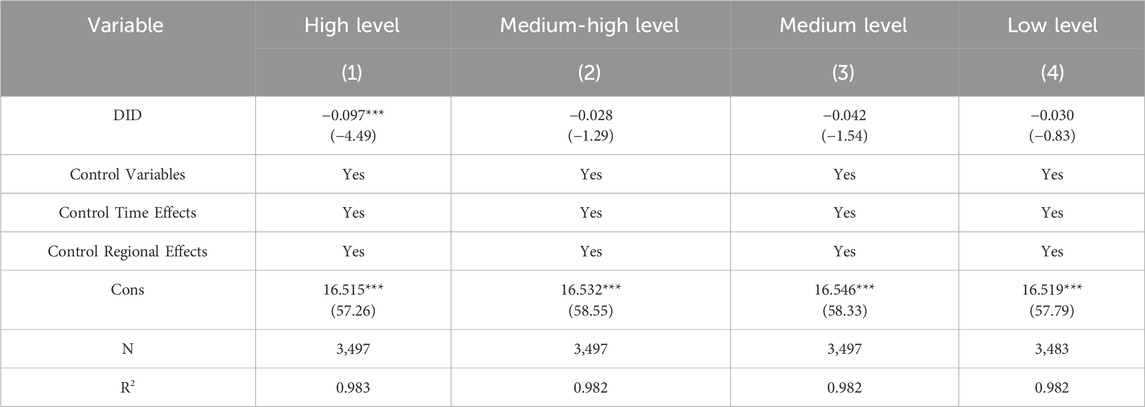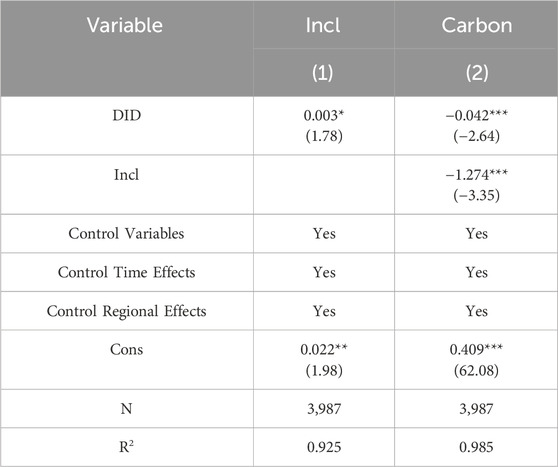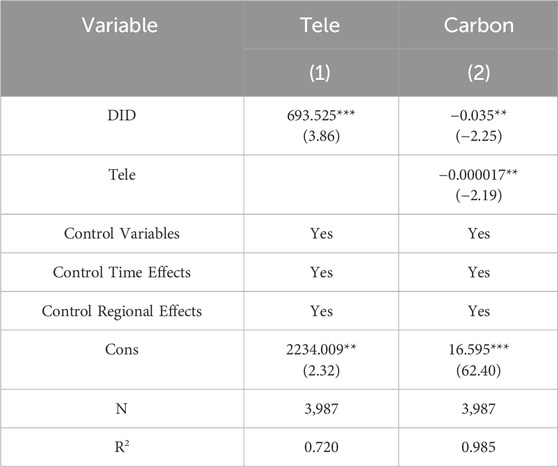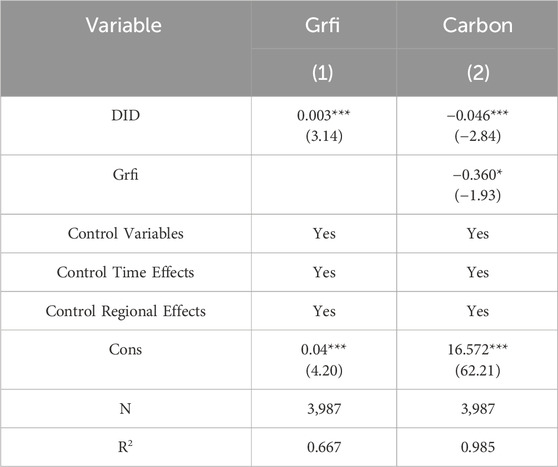- 1School of Food and Health, Beijing Technology and Business University, Beijing, China
- 2Zhongshang Guoneng Group Co., Ltd., Beijing, China
With the continuous improvement of China’s openness, pilot free trade zones (FTZs) have played an increasingly prominent role in promoting low-carbon transformation. A thorough exploration of the impact of FTZs development on regional low-carbon growth holds significant theoretical and practical value for advancing high-quality green economic development. Based on panel data from 285 prefecture-level cities in China from 2009 to 2022, this study empirically examines the impact of FTZs establishment on regional carbon emission reduction and its underlying mechanisms. The results show that FTZs development has a significant positive effect on regional green and low-carbon transformation. However, this effect exhibits heterogeneity depending on geographical location and industrial structure, with FTZs in coastal regions and those dominated by the tertiary sector demonstrating a more pronounced contribution to carbon reduction. Further analysis reveals that the promotion of green and low-carbon transformation by FTZs is primarily achieved through three key pathways: facilitating green technological innovation, enhancing industrial agglomeration, and optimizing green finance. Based on the research findings, this paper puts forward the following recommendations to promote green development: leveraging green policies to guide the green transformation of industries; adopting region-specific strategies to advance differentiated regional green development; fostering high-quality green development through technological innovation and diversified approaches; and strengthening green risk management to safeguard both economic and ecological security.
1 Introduction
As global climate change intensifies, carbon emission reduction has become an urgent challenge for economic development worldwide. Effectively controlling carbon emissions while ensuring economic growth has become a central concern for governments and academia alike. The report of the 20th National Congress of the Communist Party of China explicitly emphasizes the need to “promote green development and build a beautiful China,” advocating an accelerated transition to a green and low-carbon economy to advance ecological civilization. Green and low-carbon development is essential for achieving sustainable growth, as it involves not only environmental protection and energy restructuring but also greater demands on industrial transformation, technological innovation, and capital flows. Characterized by sustainability, innovation, and synergy, green development serves as a crucial foundation for high-quality economic progress.
Against the backdrop of global climate governance and the push for a green and low-carbon transition, China’s pilot free trade zones (FTZs) have played an active role in carbon emission reduction. By leveraging industrial agglomeration effects, policy innovation, and market-driven mechanisms, FTZs have accelerated the innovation and application of green technologies while providing vital support for the flow and accumulation of green capital (Zilian and Liu, 2021; Jia and Hua, 2024). Additionally, FTZs promote the rapid growth of green industries by offering preferential policies, facilitating trade, and ensuring free capital mobility, thereby fostering regional economic transformation toward sustainability (Wang et al., 2023). However, as regional economic integration advances, evolving external conditions and internal institutional reforms introduce new challenges and uncertainties for FTZs (Yang, 2022; Shengguo et al., 2025; Shi and Wang, 2022). For instance, balancing economic growth with environmental protection, preventing excessive resource consumption during industrial agglomeration, and effectively utilizing green finance remain pressing issues that require further exploration. In response, this study investigates how FTZs contribute to carbon emission reduction through three key mechanisms: industrial agglomeration, technological innovation, and green finance. Specifically, it aims to answer the following research questions: How does industrial agglomeration in FTZs foster the innovation and application of green technologies? What role does green finance play in supporting carbon reduction objectives within pilot FTZs? What opportunities and challenges do different regions face in transitioning to a green and low-carbon economy? Addressing these questions will provide a deeper understanding of the multifaceted role of FTZs in green development, elucidate their carbon reduction mechanisms, and offer both theoretical insights and empirical evidence to inform policymaking. Ultimately, this research seeks to enhance the contribution of China’s FTZs toward achieving green development and carbon reduction targets.
The literature relevant to this study can be categorized into three main strands. ① Research on Carbon Emission Reduction and Green Low-Carbon Transition. As a key strategy for addressing global climate change, carbon emission reduction involves interactions across multiple domains. From a policy perspective, governments worldwide have implemented measures such as carbon pricing, emissions trading schemes, and green finance to drive carbon reductions and achieve climate mitigation targets (Liu et al., 2019; Kossof, 2014; Jiang et al., 2020). Meanwhile, industrial restructuring and technological innovation serve as core drivers of carbon reduction. The rapid advancement of low-carbon technologies and green industries has significantly improved energy efficiency and reduced carbon emissions (Lin and Sun, 2011). Additionally, growing public awareness of environmental issues and the promotion of green consumption are essential factors contributing to emission reduction efforts (Su et al., 2021). ② Impact of Pilot Free Trade Zones on Green Transition. As a critical policy instrument for promoting high-quality economic development, FTZs not only enhance openness and optimize industrial structures but also play a pivotal role in advancing green and low-carbon transitions. FTZs facilitate industrial agglomeration, technological innovation, and green capital flows, providing both policy support and market mechanisms for the dissemination of low-carbon technologies and the development of green industries (Yu et al., 2024). Existing studies suggest that FTZs can accelerate green industrial development and contribute to carbon reduction through preferential policies, financial incentives, and technological advancements (Jia and Hua, 2024). However, some research highlights potential risks, arguing that in certain cases, FTZs may lead to excessive dependence on traditional high-pollution industries and fail to effectively guide green industry clustering, posing dual risks to both environmental sustainability and economic stability (Gong et al., 2023; Shi and Wang, 2022). ③ Discussions on Carbon Emission Reduction and Economic Security. The relationship between carbon emission reduction and economic security has attracted increasing academic attention. Carbon reduction not only mitigates greenhouse gas emissions but also enhances energy independence and strengthens the economic resilience of regions (Wu et al., 2022; Lee, 2022). On the one hand, the development of green and low-carbon industries can improve economic security by reducing dependence on external energy sources. On the other hand, poorly designed carbon reduction policies may lead to inefficient industrial restructuring or excessive adjustments, potentially undermining regional economic stability.
The aforementioned literature provides a solid theoretical foundation for this study. However, further research is needed to explore the specific impacts and mechanisms through which FTZs influence carbon emission reduction. The existing gaps in the literature can be summarized as follows. Current studies primarily focus on policy frameworks and macro-level analyses, lacking in-depth investigations into how FTZs promote carbon reduction mechanisms during their implementation in specific cities. While some research touches upon the role of FTZs in driving carbon emission reductions, most studies do not incorporate empirical data for detailed analysis, and quantitative empirical research remains limited. Additionally, existing studies on green and low-carbon transitions rarely examine the specific contributions of FTZs as a policy instrument in achieving carbon reduction targets. Furthermore, comparative analyses of the effectiveness of FTZ policies across different regions remain insufficient. To address these gaps, this study will analyze the impact of FTZs on carbon reduction based on a multidimensional framework, integrating perspectives on industrial agglomeration, technological innovation, and green finance. Moreover, it aims to unveil the underlying mechanisms through which FTZs contribute to carbon emission reduction.
This study makes the following marginal contributions. Building upon existing research on green and low-carbon transitions, it investigates how FTZs promote carbon emission reduction through multiple mechanisms, including industrial agglomeration, technological innovation, and green finance, thereby providing a new theoretical perspective for carbon reduction policies. Through empirical analysis, the study reveals the specific effects of FTZs in facilitating carbon reduction, offering data-driven support for policymakers. Moreover, it provides theoretical foundations and policy recommendations for achieving green and low-carbon transitions while simultaneously enhancing economic security. Ultimately, this research aims to guide FTZs in balancing “openness” and “greenness” in the pursuit of high-quality economic development.
2 Theoretical analysis
Against the backdrop of global climate change and environmental governance, carbon emission reduction has become a strategic development goal for many countries. As key platforms for regional economic development and reform, FTZs have played an increasingly important role in promoting carbon reduction in recent years. The pathways and mechanisms of carbon reduction are complex and multifaceted, involving policy incentives, industrial restructuring, and technological innovation (Yang et al., 2019). Among these, the effective integration of policy guidance and market mechanisms serves as a crucial foundation for driving carbon reduction (Wu et al., 2021), while optimizing industrial structures and adopting clean energy are key approaches to achieving carbon reduction targets (Bin et al., 2019). Existing research provides a solid theoretical foundation for analyzing the role of FTZs in carbon reduction. Building upon this, the present study examines carbon reduction mechanisms from both macro-level policy perspectives and micro-level practical implementations. The carbon reduction mechanisms in FTZs not only concretely embody national carbon reduction strategies but also serve as essential tools for local governments to address climate change through policy innovation and industrial transformation. At the regional level, these mechanisms encompass multiple factors, including government-implemented green policies, the low-carbon transformation of industrial chains, and the market-driven application of clean technologies. These factors interact synergistically to drive FTZs toward green development, low-carbon economies, and sustainable growth. Based on this framework, this study explores the carbon reduction mechanisms and impact pathways of FTZs by focusing on policy measures, industrial restructuring, and green technological innovation.
Overall, the core characteristic of FTZs lies in their ability to enhance economic development momentum by promoting the free flow and optimal allocation of production factors. The impact of FTZs on carbon reduction can be summarized in two main aspects: ① Promoting Green Technology, Low-Carbon Industries, and Clean Energy. FTZs accelerate the agglomeration and innovation of key elements such as green technology, low-carbon industries, and clean energy, thereby fostering regional green economic development and enhancing carbon reduction capabilities (Liang, 2021). As crucial platforms for reform and opening-up, FTZs facilitate the introduction of advanced green technologies, optimize industrial structures, and improve energy efficiency, which in turn promotes the application and diffusion of low-carbon technologies (Shahid et al., 2024). Supported by green industries and clean energy, the carbon intensity of regional economic activities can be reduced, enhancing environmental sustainability and providing robust support for carbon reduction. ② Potential Carbon Reduction Risks Due to Rapid Liberalization. While FTZs contribute to carbon reduction, rapid liberalization and high economic openness may lead to imbalanced green development and pose certain risks. Although the establishment of FTZs stimulates the growth of green technologies and industries, their high degree of openness and policy flexibility may prolong the transition period of traditional high-carbon industries, making a complete low-carbon transformation challenging in the short term. External pressures and delays in internal structural adjustments may result in carbon reduction outcomes that fall short of expectations, or even temporary increases in emissions. These risks may arise from incomplete policy implementation, insufficient industry regulation, and uneven adoption of green technologies, ultimately affecting the long-term effectiveness of FTZ carbon reduction policies. These two opposing trends interact to shape the overall impact of FTZs on carbon reduction. The magnitude of this impact depends on the effectiveness of policy implementation and the adaptability of regional industrial structures. Given the significant achievements of FTZs in promoting green development and their capacity to mitigate some carbon emission risks through institutional innovation, it can be preliminarily concluded that FTZs have a positive overall effect on carbon reduction. By driving green technological innovation and industrial transformation, FTZs contribute to reducing carbon emissions. However, this conclusion requires further empirical validation. Specifically, the mechanisms through which FTZs influence carbon reduction can be analyzed from the following three perspectives:
2.1 Free trade pilot zones promote carbon reduction through industrial agglomeration
Industrial agglomeration typically enhances regional economic vitality, and the establishment of FTZs has the potential to significantly promote carbon reduction by encouraging industrial clustering. According to spatial economics theory, a core objective of FTZs is to foster the concentration of industries and technologies through policy support and optimized resource allocation (Shijie and Tingru, 2019; Liang, 2021). Leveraging their institutional advantages, FTZs facilitate the rapid clustering of green and low-carbon industries within designated regions, thus promoting efficient resource utilization and advancing carbon reduction objectives. Furthermore, the benefits of FTZ-induced agglomeration extend beyond local boundaries, generating spillover effects that optimize regional industrial structures and promote the broader diffusion of green industries (Cao et al., 2020). Empirical evidence from FTZs in regions such as Shanghai and Zhejiang illustrates that industrial clustering can significantly contribute to carbon reduction and the widespread adoption of green technologies. For instance, in the Shanghai FTZ, the development of green industry clusters has spurred rapid growth in sectors such as clean energy and low-carbon manufacturing. Through centralized technological innovation and inter-industry collaboration, substantial reductions in carbon emissions have been achieved. The policy-driven aggregation of resources within FTZs has also facilitated the improvement of green industrial chains, creating a favorable ecosystem for the deployment of low-carbon technologies. By lowering innovation costs and integrating green industries with traditional sectors, industrial agglomeration enhances the overall efficiency of emission reduction efforts. Additionally, the formation of green clusters accelerates the commercialization and scaling-up of low-carbon technologies, thereby reinforcing industrial transformation. This process, underpinned by policy incentives, resource concentration, and industrial synergy, establishes a virtuous cycle that supports long-term carbon reduction goals. For example, in the Guangdong FTZ, the clustering of industries such as new energy vehicles and renewable energy has fostered collaborative innovation, contributing to further decreases in carbon emissions.
2.2 Technological innovation promotes carbon reduction in free trade pilot zones
Technological innovation serves as a pivotal driver of the low-carbon economy and plays a crucial role in helping FTZs achieve their carbon reduction objectives. Leveraging their institutional and policy advantages, FTZs effectively stimulate both the development and deployment of green technologies. By offering preferential policies, financial incentives, and a supportive regulatory environment, FTZs foster a favorable innovation ecosystem that accelerates the advancement of low-carbon technologies. These zones attract substantial research funding and innovative talent by providing clear development prospects and policy stability, thereby enhancing regional innovation capacity and enabling breakthroughs in green technology. FTZs also function as technological clusters, bringing together enterprises and research institutions under tailored innovation systems. For instance, the Shanghai FTZ has implemented green industrial policies and tax incentives that have attracted numerous entities in sectors such as renewable energy, environmental protection, and energy efficiency. This concentration of resources facilitates both the innovation and diffusion of green technologies, thereby supporting systemic carbon reduction. In addition, FTZs serve as platforms for foreign investment and international technology transfer. With strong institutional support, these zones accelerate the application of low-carbon solutions in key sectors like energy, transportation, and construction, leading to a notable decline in carbon intensity. Technological innovation within FTZs encompasses not only the invention of new technologies but also the adaptation and scaling of existing solutions. A case in point is the Guangdong FTZ, which actively promotes the development of the new energy vehicle (NEV) industry. Policies encouraging the adoption of electric vehicles, the expansion of charging infrastructure, and the integration of related technologies have significantly reduced reliance on fossil fuels. Moreover, the region is fostering clean energy adoption and smart energy management systems, further consolidating its low-carbon transition.
2.3 Free trade pilot zones drive carbon reduction through green funds
Green funds constitute a vital financial mechanism for supporting the growth of green and low-carbon industries, thereby contributing significantly to the achievement of carbon reduction targets. As pioneering platforms for institutional innovation, Free FTZs actively leverage green funds to advance green technologies and sustainable projects, accelerating the transition toward a low-carbon economy. From a financial perspective, FTZs utilize policy incentives and institutional support to establish and operate green funds that channel capital into environmental protection, clean energy, and low-carbon technology initiatives. These funds bridge the financing gap for innovation-driven enterprises and catalyze the expansion of green industries, ultimately reducing regional carbon emissions. Functioning as aggregators of social capital, green funds within FTZs provide stable, long-term funding for the research, development, and deployment of low-carbon technologies. For instance, the Zhejiang FTZ has launched a dedicated green development fund that supports renewable energy projects, energy-saving facilities, and emissions reduction infrastructure. This initiative has facilitated the scaling of clean energy adoption while reducing reliance on fossil fuels. Moreover, green funds significantly lower financing costs and de-risk investment in sustainable technologies, expediting their commercialization and market uptake. FTZs also play a key role in enhancing the policy environment for green finance. For example, the Guangdong FTZ has introduced a series of fiscal and tax incentives to promote the establishment and operation of green funds, mobilizing private capital and reinforcing public-private collaboration in the green economy. By creating favorable policy conditions and financial frameworks, FTZs ensure efficient capital allocation toward decarbonization goals. In doing so, they not only promote technological innovation but also support the broader structural transformation toward sustainability.
3 Research design
3.1 Variable selection
3.1.1 Dependent variable
In this paper, the carbon emissions are calculated based on the carbon emission calculation method published by the IPCC guidelines (2006) (Solomon et al., 2007), and referencing the research process of scholars such as Xie (2022). The formula for calculating carbon emissions is as follows:
Where Carbon represents carbon dioxide emissions; i denotes the type of fossil fuel; Ei represents the consumption of fossil fuels; NCVi represents the average lower heating value of fossil fuels; and CEFi represents the carbon emission factor of fossil fuels. This study considers carbon emissions from nine types of energy, including raw coal, with the energy carbon emission factors provided in Table 1.
3.1.2 Core explanatory variable
The core explanatory variable in this study is the FTZs. The experimental group consists of cities where FTZs were established before 2022 by the State Council. If a city has an FTZ, the variable FTZ is assigned a value of 1; otherwise, it is assigned a value of 0. The data for FTZ pilot cities comes from the list of Free Trade Zones disclosed by the Ministry of Commerce of the People’s Republic of China. The 11 prefecture-level cities involved in the four major FTZs expanded in 2020 (Beijing, Hunan, Anhui, and Zhejiang) are included in the experimental group. The FTZ establishment time is based on the first establishment date. Due to the time interval limitation in the sample selection, the Xinjiang FTZs established in 2023, covering Urumqi and Kashgar, are not within the sample period and will be treated as the control group.
3.1.3 Control variables
To isolate the effect of the FTZ policy on carbon emissions, this study incorporates several control variables to account for other influencing factors, drawing on the approaches of numerous scholars. Specifically, we select three control variables: economic development level, industrial structure, and technological level.
① Economic Development Level (Ecle). The level of economic development effectively reflects regional disparities in economic strength, directly influencing industrial layout and technological innovation capacity. It is considered a core determinant of regional carbon emissions (Zhou et al., 2019; Wen et al., 2020). In this study, it is measured by the logarithm of per capita GDP.
② Industrial Structure (Incl). The share of the tertiary industry in GDP reflects the upgrading of the regional economic structure and the development level of the service sector. Optimizing industrial structure is a key factor in promoting high-quality economic growth and can significantly reduce environmental pollution (Tian et al., 2014; Zheng et al., 2021). Here, it is represented by the ratio of the value added of the tertiary industry to GDP.
③ Technological Level (Tele). Technological progress is the driving force behind industrial upgrading and improved production efficiency. It serves as an important indicator for evaluating regional industrial technology and development status, and plays a critical role in constraining carbon emissions (Hu et al., 2005; Chen et al., 2022). This variable is measured by the ratio of industrial electricity consumption to the value added of the secondary industry.
3.2 Data sources
The carbon emission data and other related data used in this study primarily come from the China Rural Statistical Yearbook, China Social Statistical Yearbook, China Urban and Rural Statistical Yearbook, and various government websites and work reports at different administrative levels. In cases of missing data, interpolation methods were employed to fill in the gaps. As a result, the final dataset includes panel data for 285 prefecture-level cities across China from 2009 to 2022. The descriptive statistics of the main indicators are shown in Table 2.
3.3 Model design
This study adopts the Difference-in-Differences (DID) method, using the implementation of the FTZs policy as a quasi-natural experiment, to examine whether the establishment of FTZs contributes to carbon reduction. Drawing on the approach of Wu et al. (2022), the following Difference-in-Differences model is constructed:
In this model,
In addition, Obor indicates whether a region is part of the pilot free trade zone policy; it takes the value of 1 if the region belongs to a free trade zone, and 0 otherwise. Time is a time dummy variable representing the implementation period of the free trade zone policy; it is assigned a value of 1 during and after the implementation of the policy, and 0 otherwise (Table 3).
4 Empirical analysis
4.1 Baseline regression
Table 4 presents the results of the baseline regression (Equation 2). Column (1) shows the regression without control variables, while Columns (2) and (3) incorporate control variables. Column (3) excludes provincial capitals to assess whether the results are influenced by these cities. Column (1) shows that the coefficient of the interaction term for FTZ establishment is significantly negative at the 1% level, indicating that the establishment of FTZs has a significant carbon reduction effect. This result is consistent with previous analyses. Column (2) adds control variables, including economic level, industrial structure, and technological level. Despite the addition of these control variables, the negative effect of FTZ establishment on carbon emissions remains significant. This suggests that the green transformation effect of FTZs is not significantly disturbed by other economic factors, further validating the independent role of FTZs in carbon reduction. Column (3) excludes provincial capitals from the sample. Provincial capitals tend to be more economically developed and have stronger carbon emission characteristics. However, after excluding these cities, the negative carbon reduction effect of FTZs remains significant. This indicates that the carbon reduction effect of FTZs is not limited to more developed regions and is applicable to a broader range of areas. The results in Table 4 confirm the robustness of the findings, showing that the establishment of FTZs contributes significantly to carbon emission reduction across various regions, irrespective of local economic conditions.
4.2 Parallel trend test
One of the key assumptions in the DID methodology is that the treatment and control groups should exhibit parallel trends prior to the policy implementation. This means that the pre-intervention trends of both groups must not differ systematically. To test this assumption, this study uses an Event Study Method, following the approach of Jacobson et al. (1993), and selects the period just before the establishment of the FTZs as the baseline group for the parallel trend test. The results are presented in Figure 1. By examining the pre-policy trends between the treatment group (FTZs cities) and the control group (non-FTZs cities), the results show that the differences in the trends are statistically insignificant at the 10% level. This indicates that, prior to the establishment of FTZs, there were no significant systematic differences in the development trends between the two groups. Therefore, the parallel trends assumption holds, confirming that the use of the DID methodology to analyze the impact of FTZs on carbon reduction is appropriate and valid.
4.3 Robustness check
The baseline regression results may be influenced by other policy shocks or unobserved factors, which could introduce estimation errors. To verify the reliability of the baseline results, the following robustness checks are conducted.
4.3.1 Placebo test
In addition to the control variables, there may still be unpredictable or omitted variables that affect the model’s estimates. The presence of these factors could cause bias in the baseline regression results. To address this, a placebo test is conducted to examine the robustness of the results. A random sample of 47 cities out of the 285 sample cities is selected to construct a pseudo-treatment group, and 1,000 simulated regressions are performed. In each simulation, the pseudo-treatment group is randomly assigned the treatment effect of FTZ establishment. This generates a set of placebo regression results. The placebo test results (Figure 2) show that the distribution of the estimated coefficients is close to zero and follows a normal distribution. These placebo coefficients are significantly smaller than the actual effect of FTZ establishment observed in the baseline regression. This indicates that when randomly assigning the treatment effect, the simulated regressions yield near-zero effects, which are significantly different from the real effects. Thus, the baseline regression results are statistically reliable and robust, confirming that the observed impact of FTZs on carbon emissions reduction is not driven by random chance or confounding factors.
4.3.2 Excluding policy interference
In addition to the FTZ policy, there are other policies, such as carbon emissions trading pilot cities, the first and second batches of low-carbon pilot cities, and the New Generation Artificial Intelligence Innovation Development Pilot Zones, which may also affect carbon emissions reduction. To address this, the study systematically excludes cities under these pilot policies and re-tests the regression results. The results are shown in Table 5. After removing the cities affected by other pilot policies, the coefficient for the FTZ policy on carbon emissions remains significantly negative. This indicates that the FTZ’s effect on carbon emissions reduction is not influenced by other policy interventions, confirming the robustness of the baseline regression results.
4.3.3 Robustness test using propensity score matching (PSM)
To further verify the robustness of the baseline regression results and eliminate the potential impact of sample selection bias, this study employs the PSM method to match the treatment group with the control group. Control variables and mechanism variables are used as covariates in the matching process. The results show that all variables pass the significance test at the 5% level, and the pseudo R-squared of the logit model is 0.2246, indicating a good model fit. Based on the estimated propensity scores, a 1-to-3 nearest neighbor matching is conducted with a caliper of 0.1 to ensure strong comparability between the treatment and control groups in terms of observable characteristics. As shown in Table 6, the coefficients of the DID and PSM-DID models are −0.047 and −0.036, respectively, with only a small difference between them, indicating that the conclusions of this study are reliable.
5 Heterogeneity analysis
5.1 Regional heterogeneity
Due to significant regional differences in the location conditions, economic foundation, and development goals of FTZs, this study further explores the heterogeneous impact of FTZ establishment on carbon emissions in the Eastern, Central, Western, and Northeastern regions. Based on the regional classification standards of the National Bureau of Statistics, the national sample is divided into four major regions: Eastern, Central, Western, and Northeastern, and regression analyses are conducted for each region. The regression results show that the carbon emission reduction effect of FTZ establishment is particularly significant in the Eastern and Central regions. The DID coefficient is significantly negative at the 1% level, indicating that the establishment of FTZs effectively reduces carbon emissions in these regions (Table 7). As the most economically developed region in China, the Eastern region possesses high technological innovation capabilities and industrial upgrading potential. The construction of FTZs in this region can effectively promote the application of green and low-carbon technologies and facilitate the green transformation of energy-intensive industries, thus playing a significant role in carbon reduction. Furthermore, the business environment in the Eastern region is relatively mature, with strong government policy support, providing a solid institutional foundation for the implementation of carbon reduction measures. Similarly, the regression results for the Central region indicate that FTZs have a significant inhibitory effect on carbon emissions. This can be attributed to the fact that the Central region has been absorbing industrial transfers from the Eastern region in recent years and promoting green and low-carbon development. With the advancement of the national “dual carbon” strategy, the Central region has strengthened the layout of new energy industries and promoted environmental protection technology innovation through the FTZ platform, thus realizing carbon reduction effects. In contrast, the carbon reduction effect of FTZs in the Western region was not found to be statistically significant. This could be due to the relatively weak economic foundation in the Western region, where the industrial structure is still dominated by high-carbon-emission industries, and the process of promoting green technologies and adjusting the energy structure is relatively slow. Additionally, the vast and sparsely populated Western region has a decentralized industrial base and energy development activities, making the impact of FTZs institutional innovations and industrial optimization on overall carbon reduction relatively weak. The regression results for the Northeastern region indicate that the inhibitory effect of FTZs on carbon emissions is significantly negative at the 10% level, suggesting that although the carbon reduction effect is somewhat weaker than in the Eastern and Central regions, it still has a positive impact. As a traditional industrial base in China, the Northeastern region has high carbon emissions, and its economic growth has slowed in recent years, with significant pressure for industrial transformation. In this context, the construction of FTZs has introduced more low-carbon industries and green technologies to the region. However, due to the continued dominance of traditional energy-intensive industries, the overall carbon reduction effect is relatively limited.
5.2 Industrial structure heterogeneity
Previous studies have shown that industrial structure upgrading can promote green and low-carbon transformation by driving technological innovation and the commercialization of research results, thus enhancing carbon reduction levels (Shichun et al., 2012; Yong and Wang, 2019). However, the heterogeneity of the impact of FTZs on green and low-carbon development under different levels of industrial structure has not been widely discussed. To address this, this paper classifies cities into four categories based on their industrial structure levels: high-level, medium-high level, medium level, and low level, with classification based on the technological level and development degree of the local industries. The regression results indicate that the carbon emission reduction effect of FTZ construction is most significant in regions with high-level industrial structures. The DID coefficient is −0.097, which is significantly negative at the 1% level, indicating that FTZ construction can effectively promote carbon reduction in regions with high-level industrial structures (Table 8). This phenomenon can be explained from two aspects: first, from a theoretical perspective, industrial structure upgrading theory reveals a trend of continuous upgrading of industrial structures. FTZ construction, by promoting the development of emerging industries and green technologies, can help regions with high-level industrial structures further enhance the quality of economic development, achieve green and low-carbon transformation, and thus have a significant carbon reduction effect. Second, from a practical experience perspective, regions with high-level industrial structures often possess strong technological innovation capabilities and efficient industrial cluster effects. FTZ construction provides these regions with more favorable policy support and development platforms. For example, FTZs in Shanghai, Shenzhen, and other cities have seen rapid development in high-tech industries such as information technology, artificial intelligence, and environmental protection. These industries, mostly part of the tertiary sector, provide more innovation-driven momentum for FTZ development, further driving the growth of a low-carbon economy and producing a more significant carbon reduction effect. However, the regression results also indicate that the carbon reduction effects in regions with medium-high, medium, and low-level industrial structures are relatively weak and do not reach significance levels. This may be due to the weaker industrial foundation in these regions, where green transformation and industrial upgrading are still in the early stages. These regions are constrained by factors such as technological innovation capacity, industrial policy support, and the degree of marketization, making it difficult for FTZ construction to exhibit a noticeable effect on carbon reduction.
6 Mechanism test
As previously confirmed, the establishment of FTZs has significantly reduced regional carbon emissions, with the relationship between FTZs and emissions further explored through location and industrial structure heterogeneity. To deepen the understanding of the impact of FTZ construction on carbon emissions, this paper investigates its underlying mechanisms, specifically how FTZ policies influence carbon emissions through specific pathways. Based on the preceding analysis, this paper explores three key mechanisms by which FTZs affect carbon emissions: promoting industrial agglomeration, driving technological advancements, and fostering the development of green finance.
6.1 Promoting industrial agglomeration
To further explore the mechanism of how FTZ construction affects carbon emissions, this paper selects industrial agglomeration as a mediating variable for testing. Following the approach of Yang (2013), the number of employees per unit administrative area is used to represent the level of industrial agglomeration. The regression results are shown in Table 9. The results indicate that the establishment of FTZs has a significant positive effect on industrial agglomeration, suggesting that FTZs can effectively promote regional industrial clustering. Furthermore, in the regression model controlling for industrial agglomeration (column 2), the direct impact of FTZ construction on carbon emissions is significantly negative (DID coefficient = −0.042, significant at the 1% level), and industrial agglomeration also has a significant negative effect on carbon emissions (Incl coefficient = −1.274, significant at the 1% level). This indicates that industrial agglomeration plays a partial mediating role between FTZ construction and carbon emissions.
The results indicate that FTZ construction can reduce regional carbon emissions by promoting industrial agglomeration, which in turn fosters green technology innovation and optimizes the allocation of production factors. This conclusion is consistent with related studies, such as the research by Pearson and Foxon (2012), which suggests that industrial agglomeration helps to create economies of scale, improve energy utilization efficiency, and alleviate carbon emission pressure to some extent. Furthermore, from practical experience, many FTZs place high importance on the agglomeration of green industries. For instance, regions like Shanghai, Shenzhen, and Hainan have supported the development of high-end manufacturing, clean energy industries, and modern services through FTZ policies. The strengthening of industrial agglomeration in these areas has further driven the green and low-carbon transformation, thereby reducing regional carbon emissions.
6.2 Improving technological level
To further explore the mechanism of the FTZ construction on carbon emissions, this paper uses the number of green invention patents granted as a proxy for technological advancement to test the mediating effect of technological level. The regression results are shown in Table 10. The results indicate that the construction of FTZs has a significantly positive impact on technological level (Column 1, DID coefficient = 693.525, significant at the 1% level), suggesting that the establishment of FTZs effectively promotes technological progress in the region. In the regression model controlling for technological level (Column 2), the direct impact of FTZ construction on carbon emissions is significantly negative (DID coefficient = −0.035, significant at the 5% level), and the impact of technological level on carbon emissions is also significantly negative (Tele coefficient = −0.000017, significant at the 5% level), indicating that technological level plays a partial mediating role between FTZ construction and carbon emissions. FTZ construction can promote technological advancement, thereby fostering green technological innovation, improving energy efficiency, and ultimately reducing regional carbon emissions.
6.3 Developing green finance
To further explore the mechanism through which the FTZ. construction affects carbon emissions, this study selects green finance (Grfi) as a mediating variable for testing. Specifically, green funds are used as a proxy for green finance. Green funds are defined as public or private funds that specifically invest in environmental protection, energy conservation and emission reduction, clean energy, pollution control, and related green industries. The selection of green funds is based on explicit green or environmental investment orientations stated in the fund prospectuses and portfolio reports, conforming to the standards of the Asset Management Association of China and international green funds. The total market value data of green funds are sourced from authoritative financial databases, and the level of green finance development is measured by the ratio of the total market value of green funds to the total market value of all funds.
Based on this, the mediating effect of green finance between FTZ construction and carbon emissions is analyzed. Table 11 reports the regression results. The results show that FTZ construction has a significantly positive effect on green finance (Column 1, DID coefficient = 0.003, significant at the 1% level), indicating that the establishment of FTZs promotes the development of green finance. Further regression results controlling for the green finance variable (Column 2) show that the direct effect of FTZ construction on carbon emissions is significantly negative (DID coefficient = −0.046, significant at the 1% level), and green finance also has a significantly negative impact on carbon emissions (Grfi coefficient = −0.360, significant at the 10% level). This suggests that green finance partially mediates the relationship between FTZ construction and carbon emission reduction. By promoting the development of green finance, optimizing capital allocation, encouraging green technological innovation, and supporting low-carbon industries, FTZ construction effectively reduces regional carbon emission levels.
7 Conclusion and implications
7.1 Research conclusion
This paper, based on panel data from 285 prefecture-level cities between 2009 and 2022, thoroughly analyzes the impact of FTZs on carbon reduction and its mechanisms. The study finds that FTZ construction has a significant carbon reduction effect in promoting green and low-carbon transformation, with this effect showing heterogeneity across different regions and industrial structures. Specifically, the industrial agglomeration effect, technological innovation drive, and green finance support provided by FTZs collectively contribute to the significant reduction of carbon emissions.
From a regional perspective, FTZs have a particularly pronounced inhibitory effect on carbon emissions in the eastern and central regions, whereas their carbon reduction effect is weaker in the western and northeastern regions. In terms of industrial structure, the study finds that regions with high-tech industrial structures benefit more from FTZ construction, exhibiting more significant carbon reduction effects in promoting green and low-carbon transformation. In contrast, regions with low-tech industrial structures show weaker carbon reduction effects, indicating that the optimization and upgrading of industrial structures are crucial pathways through which FTZs contribute to carbon reduction.
7.2 Policy implications
Coordinating industrial development with ecological protection is a key path to promoting green, high-quality development and achieving sustainable growth. Against the backdrop of increasing global climate change and environmental pressures, driving green development is not only a requirement for enhancing regional competitiveness but also an essential way to achieve long-term development. General Secretary Xi Jinping emphasized that green development is the only way to modernize and that ecological priority and green development must be integrated into the entire process of economic construction. Based on the research in this paper and the requirements for FTZ construction and green development, the following policy recommendations are proposed:
1. Promote Industrial Green Transformation with Green Policies as Guidance. FTZs, as experimental fields for reform and innovation, should actively promote the research and development of green and low-carbon technologies and their industrial applications, deepen the innovation of ecological and environmental protection systems, and foster the development of green industry clusters. At the policy level, more support for green technologies and green enterprises should be implemented, with favorable policies to encourage green investment, and tools like green credit should be used to guide enterprises toward green transformation. Furthermore, environmental regulation should be strengthened, a green development standard system should be enhanced, and corporate responsibilities for green development should be defined and implemented, driving FTZ enterprises to achieve resource efficiency and reduce pollutant emissions, thus creating a green economy from the source.
2. Tailor strategies to local conditions to promote differentiated regional green development. Given the differences in ecological resource endowments, economic foundations, and development stages across regions, the green transition should be guided by region-specific development strategies. Resource-dependent areas can focus on developing clean energy, ecological agriculture, and other green industries to reduce reliance on traditional high-pollution sectors. Coastal regions, on the other hand, should promote green manufacturing, marine ecological protection, and green finance, thereby achieving an organic integration of environmental sustainability and industrial upgrading. FTZs in North China, Central China, and Northeast China should actively reduce dependence on chemical fertilizers and pesticides, increase investment in machinery and technology, and raise the proportion of green agriculture to support food security. It is also essential to foster complementary and coordinated green development among cities within the FTZs to avoid homogeneous competition and promote the agglomeration effects of green industries within the region.
3. Promote Green High-Quality Development through Technological Innovation and Diversified Approaches. Technological innovation is the core driving force for green transformation. FTZs should vigorously support the research and application of green technologies, promoting the upgrading and innovation of green manufacturing, green energy, environmental protection technologies, and other industries. By increasing financial support and technological innovation for green tech enterprises, FTZs can attract more green innovation-driven companies, pushing for the industrial application of environmental technologies. Additionally, optimizing resource allocation and promoting green collaboration along the entire industrial chain through information technology, intelligence, and other methods can enhance the efficiency of the green industry chain, achieving a win-win situation of energy conservation, emission reduction, and sustainable development.
4. Strengthen Green Risk Management to Safeguard Economic and Ecological Security. Green development not only requires improving economic efficiency but also focuses on protecting the ecological environment and managing risks. During the construction of FTZs, a comprehensive green risk management mechanism should be established to identify and avoid potential ecological and environmental risks, ensuring that the development of green industries does not come at the expense of the ecological environment. Emphasis should be placed on greening and eco-friendliness throughout the industrial chain, avoiding over-exploitation and chaotic resource consumption. Strict environmental impact assessment and post-assessment systems should be formulated, with enhanced monitoring and penalties for pollution sources. Additionally, ecological compensation mechanisms should be leveraged to guide companies toward greener and low-carbon production methods, promoting the mutual enhancement of ecological safety and economic development.
Data availability statement
The original contributions presented in the study are included in the article/supplementary material, further inquiries can be directed to the corresponding author.
Author contributions
XH: Conceptualization, Data curation, Writing – original draft. HW: Investigation, Methodology, Resources, Supervision, Writing – review and editing.
Funding
The author(s) declare that no financial support was received for the research and/or publication of this article.
Conflict of interest
Authors XH and HW were employed by Zhongshang Guoneng Group Co., Ltd.
Generative AI statement
The author(s) declare that no Generative AI was used in the creation of this manuscript.
Publisher’s note
All claims expressed in this article are solely those of the authors and do not necessarily represent those of their affiliated organizations, or those of the publisher, the editors and the reviewers. Any product that may be evaluated in this article, or claim that may be made by its manufacturer, is not guaranteed or endorsed by the publisher.
References
Bin, X., Chen, Y., and Shen, X. (2019). Clean energy development, carbon dioxide emission reduction, and regional economic growth. Econ. Res. 54 (07), 188–202.
Cao, X., Zhang, S., and Shengguo, Y. (2020). Employment effects of free trade zones: does it siphon or radiate? Contemp. Finance (11), 3–14. doi:10.13676/j.cnki.cn36-1030/f.2020.11.002
Chen, F., Wang, M., and Pu, Z. (2022). The impact of technological innovation on air pollution: firm-level evidence from China. Technol. Forecast. Soc. Change 177, 121521. doi:10.1016/j.techfore.2022.121521
Gong, E., Zhang, J., and Yang, Z. (2023). Does the free trade zone pilot promote high-quality urban development? Explor. Econ. Issues (04), 102–120.
Hu, A. G., Jefferson, G. H., and Jinchang, Q. (2005). R&D and technology transfer: firm-level evidence from Chinese industry. Rev. Econ. Statistics 87 (4), 780–786.
Jia, C., and Hua, Y. (2024). Does China's free trade zone suppress environmental pollution? — Empirical research from 281 cities in China. China Environ. Manag. 16 (03), 82–91. doi:10.16868/j.cnki.1674-6252.2024.03.082
Jiang, H., Wang, W., Wang, L., and Wu, J. (2020). Research on the carbon emission reduction effect of China's green finance development — based on green credit and green venture capital. Financ. Forum 25 (11), 39–48+80. doi:10.16529/j.cnki.11-4613/f.2020.11.006
Kossof, P. (2014). China's pilot free trade zone: Shanghai free trade zone and the potential future of free trade zones in mainland China.
Lee, J. W. (2022). Strategic approaches to sustainable regional development: an exploratory study of the China (Anhui) pilot free trade zone. J. Asian Finance, Econ. Bus. 9 (7), 41–52.
Liang, Z. (2021). Discussion on the mechanism of free trade zones driving regional industrial structure upgrading. Econ. Syst. Reform (03), 122–127.
Lin, B., and Sun, C. (2011). How to achieve carbon reduction goals while ensuring China's economic growth. Soc. Sci. China (01), 64–76+221.
Liu, C., Sun, Z., and Jin, Z. (2019). Research on the policy effects of carbon emission trading pilot projects in China. China Popul. Resour. Environ. 29 (11), 49–58.
Pearson, P. J., and Foxon, T. J. (2012). A low carbon industrial revolution? Insights and challenges from past technological and economic transformations. Energy policy 50, 117–127. doi:10.1016/j.enpol.2012.07.061
Shahid, R., Shahid, H., Shijie, L., Mahmood, F., and Yifan, N. (2024). Impact of opening-up on industrial upgrading in global value chain: a difference-in-differences estimation for Shanghai pilot free trade zone. Kybernetes 53 (12), 6139–6154. doi:10.1108/k-03-2023-0440
Shengguo, Y., Zhang, Y., Ya, L., and Qu, Z. (2025). The impact of free trade zones on urban energy utilization efficiency — based on a quasi-natural experiment in China's prefecture-level cities. J. Hainan Univ. Humanit. Soc. Sci. Ed., 1–10. doi:10.15886/j.cnki.hnus.202409.0156
Shi, B., and Wang, P. (2022). Pathways for green finance development in hebei’s free trade zone. Hebei Finance (05), 57–60. doi:10.14049/j.cnki.hbjr.2022.05.013
Shichun, X., Rong, X., and He, Z. (2012). Analysis of the influencing factors of China's energy consumption carbon emissions and policy implications. Resour. Sci. 34 (01), 2–12.
Shijie, L., and Tingru, Z. (2019). Has the free trade zone promoted industrial structure upgrading? — Empirical analysis based on China (Shanghai) free trade zone. J. Central Univ. Finance Econ. (08), 118–128. doi:10.19681/j.cnki.jcufe.2019.08.010
Solomon, S., Qin, D., Manning, M., Chen, Z., Marquis, M., Averyt, K., et al. (2007). IPCC fourth assessment report (AR4). Clim. Change 374.
Su, J., Liang, Y., Ding, L., Zhang, G., and Liu, H. (2021). Discussion on energy development strategy in China under the carbon neutrality goal. Bull. Chin. Acad. Sci. 36 (09), 1001–1009. doi:10.16418/j.issn.1000-3045.20210727001
Tian, X., Chang, M., Shi, F., and Tanikawa, H. (2014). How does industrial structure change impact carbon dioxide emissions? A comparative analysis focusing on nine provincial regions in China. Environ. Sci. and Policy 37, 243–254. doi:10.1016/j.envsci.2013.10.001
Wang, Z., Yu, Z., and Ma, L. (2023). Has the establishment of free trade zones promoted low-carbon development in cities? China Popul. Resour. Environ. 33 (08), 48–61.
Wen, Y., Hu, P., Li, J., Liu, Q., Shi, L., Ewing, J., et al. (2020). Does China’s carbon emissions trading scheme really work? A case study of the Hubei pilot. J. Clean. Prod. 277, 124151. doi:10.1016/j.jclepro.2020.124151
Wu, X., Guo, C., Yi, X., Lu, J., and Wang, L. (2022). Research on China's economic and social development under the 'dual carbon' goal. Macroecon. Res. (05), 5–21. doi:10.16304/j.cnki.11-3952/f.2022.05.003
Wu, Y., Qi, J., Xian, Q., and Chen, J. (2021). Study on the carbon emission reduction effect of China's carbon market — from the perspective of the synergistic role of market mechanisms and administrative interventions. China Ind. Econ. (08), 114–132. doi:10.19581/j.cnki.ciejournal.2021.08.007
Xie, Y. (2022). The impact and mechanism of digital economy on regional carbon emission intensity. Contemp. Econ. Manag. 44 (02), 68–78. doi:10.13253/j.cnki.ddjjgl.2022.02.008
Yang, D. (2022). The impact of free trade zone construction on economic growth quality — empirical analysis based on the HCW method. Econ. Syst. Reform (05), 60–66.
Yang, L., Zhu, J., and Jia, Z. (2019). Influencing factors and current challenges of carbon emission reduction in China — based on technological progress perspective. Econ. Res. 54 (11), 118–132.
Yang, R. (2013). Industrial agglomeration and regional wage disparity — empirical research from 269 cities in China. Manag. World (08), 41–52.
Yong, W., and Wang, Y. (2019). Feasibility and optimal path of achieving carbon reduction dual control goals in China — from the perspective of energy structure optimization. China Environ. Sci. 39 (10), 4444–4455. doi:10.19674/j.cnki.issn1000-6923.2019.0518
Yu, Z., Han, J., Shi, X., and Yang, Y. (2024). Estimates of the trade and global value chain (GVC) effects of China’s Pilot Free Trade Zones: a research based on the quantitative trade model. J. Asia Pac. Econ., 1–48.
Zheng, J., Shao, X., Liu, W., Kong, J., and Zuo, G. (2021). The impact of the pilot program on industrial structure upgrading in low-carbon cities. J. Clean. Prod. 290, 125868. doi:10.1016/j.jclepro.2021.125868
Zhou, B., Zhang, C., Song, H., and Wang, Q. (2019). How does emission trading reduce China's carbon intensity? An exploration using a decomposition and difference-in-differences approach. Sci. total Environ. 676, 514–523. doi:10.1016/j.scitotenv.2019.04.303
Keywords: free trade zone, green technological innovation, carbon emission reduction, industrial agglomeration, difference-in-differences
Citation: Hao X and Wang H (2025) Has China achieved carbon emission reduction through pilot free trade zones?. Front. Environ. Sci. 13:1625187. doi: 10.3389/fenvs.2025.1625187
Received: 13 May 2025; Accepted: 09 June 2025;
Published: 19 June 2025.
Edited by:
Xiang Gao, Shanghai Business School, ChinaReviewed by:
Yi Li, Chongqing Technology and Business University, ChinaMiao Miao Yi, East China University of Science and Technology, China
Copyright © 2025 Hao and Wang. This is an open-access article distributed under the terms of the Creative Commons Attribution License (CC BY). The use, distribution or reproduction in other forums is permitted, provided the original author(s) and the copyright owner(s) are credited and that the original publication in this journal is cited, in accordance with accepted academic practice. No use, distribution or reproduction is permitted which does not comply with these terms.
*Correspondence: Haiping Wang, d2FuZ19oYWlwaUBvdXRsb29rLmNvbQ==
 Xiaomin Hao
Xiaomin Hao Haiping Wang2*
Haiping Wang2*